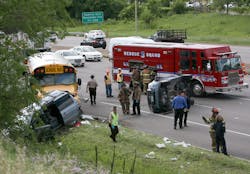Let me turn the focus to an operational area which is frequently overlooked by our fire service leaders. I am referring to our operations on the highways of our operational districts. Many times we are called out to combat car fires and to conduct extrication and rescue operations at motor vehicle incidents and accidents. Let me suggest that need to create operational guidelines to covers these things. Let me also suggest that training and equipment are needed to insure that our people are ready to conduct operations in these areas.
Let me suggest that my comments are based upon a great deal of current experience. It seems like it is my lot to spend a lot of time driving the highways and byways of my community. It also seems as though there has always been a fair share of idiots, nitwits, and cretins operating motor vehicles on the highways around me. I just accepted it at face value, because, after all, this is New Jersey, one of five worst states for driving. I will not name the others. You can fill in the blanks yourself.
However, lately I have noted a marked increase in the number people who drive as they were the sole occupant of the highway. They cut in and out, seemingly oblivious to the fact that there is a device on the steering wheel column of the car know as a turn signal. These folks jump into traffic from the many stores and shopping centers which line the side of our highways here in New Jersey.
Think about all of these folks whizzing by you as you and your fire department are out there operating on the highways of your area. They look like they are driving, I mean there they are, sitting in the car holding the steering wheel and motoring along on their way to somewhere.
But are they really in control of their car, themselves, and their emotions? Are they really driving or are they doing something else? How many of these folks are eating something? How many are chatting on their cell phones? How many of them are texting to their friends or doing their nails? How many of them are reading a newspaper or riding with their eyes glued to their global positioning systems (GPS)?
My friends, I did not dream up these scenarios for your entertainment. These are the things which I have witnessed on the roads around me. So what can you do about these people? Truth be told, there is nothing you can do about people like these. However, let me suggest that you devote all of your time to controlling those things where you have a shot at influencing the real outcomes.
What can you do? Three things come to mind quite quickly:
- Train your people to operate out on the highways in a proper manner.
- Provide them with the proper retro-reflective gear, highway signs, cones, and blocking devices.
- Stay on their case to use the training and equipment when they are out working on the roads.
Let me suggest that there is a resource available to you where you can get the help you need to address this problem area. I guess it is with a bit of pride that I would like to point out the many technical resources which are available at the ResponderSafety.com web site. This site has the wherewithal to help you get your highway operations up and running correctly.
There is a great deal of information on that site which can help you to train your troops and develop the necessary operational guidelines for use in your area. In addition, they now offer the Responder Safety Learning Network as an educational resource for your and your agency.
I would urge you to register for their Learning Network and have your people sign up too. There are a number of educational offerings which your team can use to prepare for operating safely and effectively on the highways in your area. Like I said earlier, you cannot control the people in the vehicles zooming around you. All you can do is train and equip your people. Then you can make sure that they use the training and equipment according to the operating procedures you create.
You must leave nothing to chance. Many have been the incidents during the past winter when fire and EMS personnel have been struck and injured all across the nation. Some have been killed. I am suggesting that training, education, equipment, and enforcement are the way to go.
Safety does not just happen. It never has and it never will. I strongly suggest that you must work in concert with your team to make it a part of your operation so that everyone will return safely at the end of the operation.
Recent incidents where firefighters were struck:






